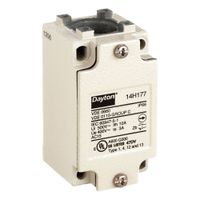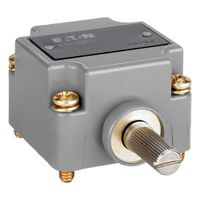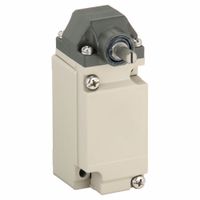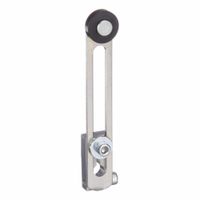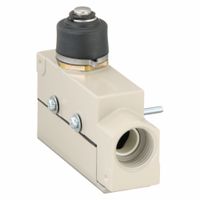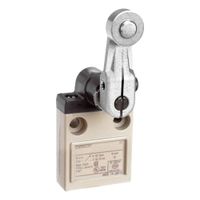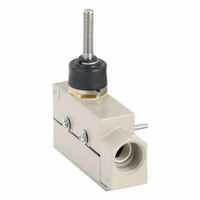Call +(254) 703 030 000 / 751 483 999 / 721 704 777
- Home
- Electrical
- Industrial Controls Automation And Machine Safety
- Limit Switches
.....Read More
Frequently Asked Questions
What is a limit switch and how does it work?
A limit switch is an electromechanical device used to detect the presence or absence of an object, or to monitor and control the movement of a machine part. It operates by making or breaking an electrical connection when a physical force is applied to its actuator. The actuator is typically a lever, plunger, or roller that is mechanically linked to the switch contacts.
When an object comes into contact with the actuator, it moves the actuator to a predetermined position, causing the internal contacts of the switch to either open or close. This change in the state of the contacts sends a signal to a control system, which can then initiate a specific action, such as stopping a motor, reversing its direction, or triggering an alarm.
Limit switches are commonly used in industrial applications to ensure safety and precision. They can be found in conveyor systems, elevators, machine tools, and automated assembly lines. They help prevent machinery from operating outside of its intended parameters, thereby reducing the risk of damage or accidents.
Limit switches are available in various designs, including snap-action, slow-break, and positive-break, each suited for different applications. They are chosen based on factors such as the operating environment, the required electrical rating, and the mechanical configuration of the system.
In summary, a limit switch is a crucial component in automation and safety systems, providing reliable feedback on the position or movement of machine parts, and enabling precise control over industrial processes.
What are the different types of limit switches?
Limit switches are electromechanical devices used to detect the presence or absence of an object, or to monitor and control the movement of a machine part. The different types of limit switches include:
1. **Lever-Type Limit Switches**: These switches use a lever arm with a roller or a plunger to actuate the switch. They are commonly used in applications where the object to be detected moves in a linear path.
2. **Plunger-Type Limit Switches**: These switches are actuated by a plunger that is pressed by the object. They are suitable for applications requiring precise positioning.
3. **Rotary Limit Switches**: These switches are activated by the rotation of a shaft. They are often used in applications involving rotating machinery, such as cranes or hoists.
4. **Wobble Stick Limit Switches**: These have a flexible rod or "wobble stick" that can be deflected in any direction to actuate the switch. They are ideal for detecting objects in multiple directions.
5. **Snap-Action Limit Switches**: These switches provide quick and precise switching action. They are used in applications where rapid response is critical.
6. **Heavy-Duty Limit Switches**: Designed for harsh environments, these switches are built to withstand extreme conditions such as high temperatures, moisture, and dust.
7. **Precision Limit Switches**: These are used in applications requiring high accuracy and repeatability, such as in CNC machines.
8. **Safety Limit Switches**: These are used in safety applications to ensure that machinery operates within safe limits, often featuring redundant contacts for reliability.
9. **Non-Contact Limit Switches**: These use magnetic, inductive, or capacitive sensors to detect the presence of an object without physical contact, suitable for applications where contact could cause damage or contamination.
How do you install a limit switch?
1. **Select the Location**: Identify the appropriate location for the limit switch installation, ensuring it is within the mechanical range of the moving part it will monitor.
2. **Turn Off Power**: Ensure all power to the machinery or equipment is turned off to prevent electrical shock or accidental activation during installation.
3. **Mount the Switch**: Secure the limit switch to a stable surface using screws or bolts. The mounting surface should be flat and rigid to prevent misalignment.
4. **Align the Actuator**: Position the actuator (lever, plunger, or roller) so it will be engaged by the moving part at the desired point. Adjust the actuator angle and position for optimal contact.
5. **Wire the Switch**: Connect the limit switch to the control circuit. Typically, this involves connecting the common (COM), normally open (NO), and/or normally closed (NC) terminals to the appropriate wires. Use wire connectors or soldering for secure connections.
6. **Secure Wiring**: Use cable ties or clamps to secure the wiring, preventing it from being pulled or damaged during operation.
7. **Test the Installation**: Restore power and manually operate the machinery to test the limit switch. Ensure the switch activates and deactivates at the correct points.
8. **Adjust if Necessary**: If the switch does not operate correctly, adjust the actuator position or switch alignment. Repeat testing until the desired operation is achieved.
9. **Final Inspection**: Conduct a final inspection to ensure all components are securely fastened and the wiring is properly insulated and routed.
10. **Document the Installation**: Record the installation details, including the switch type, location, and wiring configuration, for future reference and maintenance.
What are the applications of limit switches?
Limit switches are versatile devices used in various applications across multiple industries. Here are some of their key applications:
1. **Industrial Automation**: Limit switches are crucial in automated systems for detecting the presence, absence, or position of an object. They help in controlling machinery by providing feedback to the control system, ensuring precise operations.
2. **Conveyor Systems**: In conveyor systems, limit switches are used to detect the position of items on the belt, ensuring proper sorting, packaging, and distribution. They can also signal when a conveyor has reached its end position or when a jam occurs.
3. **Elevators and Lifts**: Limit switches are employed to determine the position of the elevator car, ensuring it stops accurately at each floor. They also act as safety devices to prevent the elevator from moving beyond its intended range.
4. **Machine Tools**: In CNC machines and other automated tools, limit switches are used to define the limits of movement, preventing over-travel and potential damage to the machine or workpiece.
5. **Safety Interlocks**: Limit switches serve as safety interlocks in machinery, ensuring that protective guards are in place before the machine operates, thus preventing accidents.
6. **Automotive Industry**: They are used in vehicles to detect the position of doors, hoods, and trunks, triggering alarms or lights if they are not properly closed.
7. **HVAC Systems**: Limit switches are used in heating, ventilation, and air conditioning systems to detect the position of dampers and ensure proper airflow.
8. **Agricultural Equipment**: In farming machinery, limit switches help in controlling the position of components like plows and harvesters, ensuring efficient operation.
9. **Robotics**: In robotics, limit switches are used to determine the position of robotic arms and other moving parts, ensuring precise and safe operation.
10. **Packaging Machines**: They are used to detect the position of packages, ensuring correct sealing, labeling, and sorting.
These applications highlight the importance of limit switches in enhancing safety, precision, and efficiency in various systems.
How do you troubleshoot a limit switch?
1. **Visual Inspection**: Check for physical damage, misalignment, or obstructions. Ensure the actuator can move freely and the switch is properly mounted.
2. **Check Connections**: Verify that all electrical connections are secure and free from corrosion or damage. Tighten any loose connections.
3. **Test for Power**: Use a multimeter to ensure the switch is receiving power. Check the voltage at the input terminals to confirm it matches the specifications.
4. **Continuity Test**: With the power off, use a multimeter to test for continuity. Place the multimeter leads on the switch terminals and actuate the switch. The multimeter should show continuity when the switch is closed and no continuity when open.
5. **Inspect Actuator**: Ensure the actuator is engaging the switch properly. Adjust the actuator or switch position if necessary to ensure proper operation.
6. **Check for Mechanical Wear**: Inspect the switch for signs of wear or damage to the internal components. Replace the switch if necessary.
7. **Test in Circuit**: Reconnect the switch and test it in the circuit. Manually actuate the switch to ensure it operates correctly within the system.
8. **Check for Debris**: Ensure there is no debris or dirt affecting the switch operation. Clean the switch and surrounding area if needed.
9. **Review Specifications**: Confirm the switch is the correct type and rating for the application. Replace it with the appropriate switch if it is not.
10. **Consult Documentation**: Refer to the manufacturer’s manual for specific troubleshooting steps and specifications.
11. **Replace if Necessary**: If the switch fails any tests or shows signs of damage, replace it with a new one.
What are the advantages of using limit switches?
Limit switches offer several advantages in various applications:
1. **Precision and Accuracy**: Limit switches provide precise and repeatable positioning, ensuring accurate control over machinery and processes.
2. **Reliability**: They are highly reliable, with a long operational life, even in harsh environments, due to their robust construction.
3. **Simplicity**: Limit switches are simple devices that are easy to install, configure, and maintain, reducing downtime and maintenance costs.
4. **Versatility**: They can be used in a wide range of applications, from industrial machinery to consumer electronics, due to their adaptability to different environments and conditions.
5. **Safety**: Limit switches enhance safety by preventing machinery from operating outside of set parameters, thus protecting equipment and operators from potential hazards.
6. **Cost-Effectiveness**: They are generally cost-effective compared to more complex sensors, providing a budget-friendly solution for position detection and control.
7. **Feedback and Control**: Limit switches provide immediate feedback to control systems, enabling real-time adjustments and improving overall system efficiency.
8. **Durability**: Designed to withstand mechanical stress, limit switches are durable and can operate effectively in extreme temperatures, dust, and moisture.
9. **Energy Efficiency**: By ensuring that machines operate within their designed limits, limit switches help in reducing energy consumption and improving operational efficiency.
10. **Compatibility**: They are compatible with a wide range of control systems and can be easily integrated into existing setups without requiring significant modifications.
These advantages make limit switches a preferred choice for many industries seeking reliable and efficient position detection solutions.
How do you select the right limit switch for an application?
To select the right limit switch for an application, consider the following factors:
1. **Application Requirements**: Determine the specific function the limit switch will perform, such as position detection, safety interlocking, or end-of-travel indication.
2. **Environment**: Assess the operating environment, including temperature, humidity, exposure to chemicals, dust, or water. Choose a switch with appropriate IP or NEMA ratings for protection.
3. **Actuator Type**: Select the actuator type based on the motion involved. Options include plunger, roller lever, and whisker types, each suited for different motion dynamics.
4. **Electrical Specifications**: Ensure the switch can handle the required voltage and current. Check for AC or DC compatibility and consider the switch's contact configuration (e.g., SPDT, DPDT).
5. **Mechanical Durability**: Evaluate the switch's mechanical life expectancy and ensure it can withstand the number of cycles required by the application.
6. **Mounting and Size**: Consider the available space and mounting options. Ensure the switch fits within the designated area and can be securely mounted.
7. **Standards and Certifications**: Verify compliance with relevant industry standards and certifications, such as UL, CSA, or IEC, to ensure safety and reliability.
8. **Cost and Availability**: Balance the cost with the required features and ensure the switch is readily available for timely implementation.
9. **Manufacturer Support**: Consider the manufacturer's reputation, support services, and warranty options to ensure long-term reliability and assistance.
By carefully evaluating these factors, you can select a limit switch that meets the specific needs of your application, ensuring optimal performance and reliability.
